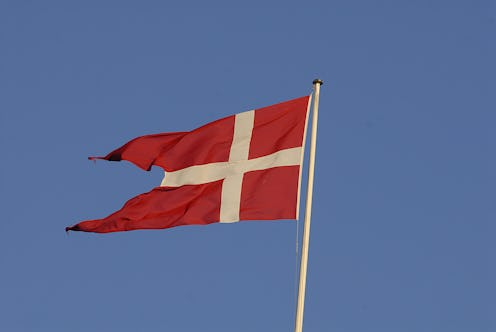News
Denmark's Newest Statue Honors A Black "Rebel Queen" & It's Regal AF

When you go to Copenhagen, there are already a couple of statues on every tourist's to-visit list. There's the Little Mermaid, there's Hans Christian Andersen, and now, you'll need to know who Mary Thomas was so that you can fully appreciate a visit to her statue in Denmark's glittering capital.
The new statue, the first of a black woman in Denmark, is the work of Danish artist Jeannette Ehlers and La Vaughn Belle, an artist from the Virgin Islands. It's called "I Am Queen Mary," and it depicts a regal looking woman sitting straight backed in a throne-like chair. According to the "I Am Queen Mary" website, the statue's pose is modeled after a 1967 photo of Huey P. Newton, who founded the Black Panther Party.
The woman behind the statue is Mary Thomas, also known as Queen Mary, who along with two other women led an uprising called "Fireburn" against the Danish colonial powers in the West Indies. The statue's unveiling coincides with the 100-year anniversary of Denmark selling its Caribbean colonies, St. Croix, St. John, and St. Thomas.
"This project is the first collaborative sculpture to memorialize Denmark’s colonial impact in the Caribbean and those who fought against it," the artists wrote on the project's website.
The first statue of a black woman in Denmark is a big deal already, but the context surrounding it makes it even more of an important step for the small, Nordic country. Although Denmark was indeed a colonial power in the Caribbean from 1672 until 1917, its colonial history is generally subsumed under discussion of the country's current success in any number of metrics. The fact that it actively took part in the slave trade, bringing thousands of Africans to the Danish colonies over almost two centuries, is something that the nation hasn't reckoned with.
“It may have to do with the narrative of Denmark as a colonial power saying, ‘We weren’t as bad as others,’” Professor Niels Brimnes, an Aarhus University expert in Danish colonialism, told the New York Times. “But we were just as bad as the others. I can’t identify a particular, humane Danish colonialism.”
Having a statue like this in a public place, however, forces people to recognize that less savory moment in Danish history, and in a way it helps to force Danish colonialism into the nation's collective memory.
“It takes a statue like this to make forgetting less easy. It takes a monument like this to fight against the silence, neglect, repression and hatred," said Henrik Holm, senior research curator at Denmark’s National Gallery of Art, in a statement to the New York Times. “Never before has a sculpture like this been erected on Danish soil. Now, Denmark is offered a sculpture that addresses the past. But it is also an artwork for the future.”
And while changing the nation's collective memory is a feat that could take centuries, Mary Thomas is an excellent representative of Denmark's past to kick things off. Labor conditions in the West Indies hadn't improved much even after slavery's abolishment, and three women — including Thomas — stepped up to lead a rebellion against the white plantation owners. Because of their role in this "Fireburn" rebellion, they came to be known as "queens." Once Danish authorities suppressed the uprising, though, the queens were shipped off to prison in Copenhagen. Thomas served part of her sentence in a women's prison in Copenhagen before being sent back to prison in the West Indies. Now, she and the other women who fought alongside her are remembered fondly and publicly in the Caribbean — and Denmark is finally beginning to catch up with the unveiling of her statue in the city where she was only brought to be imprisoned.